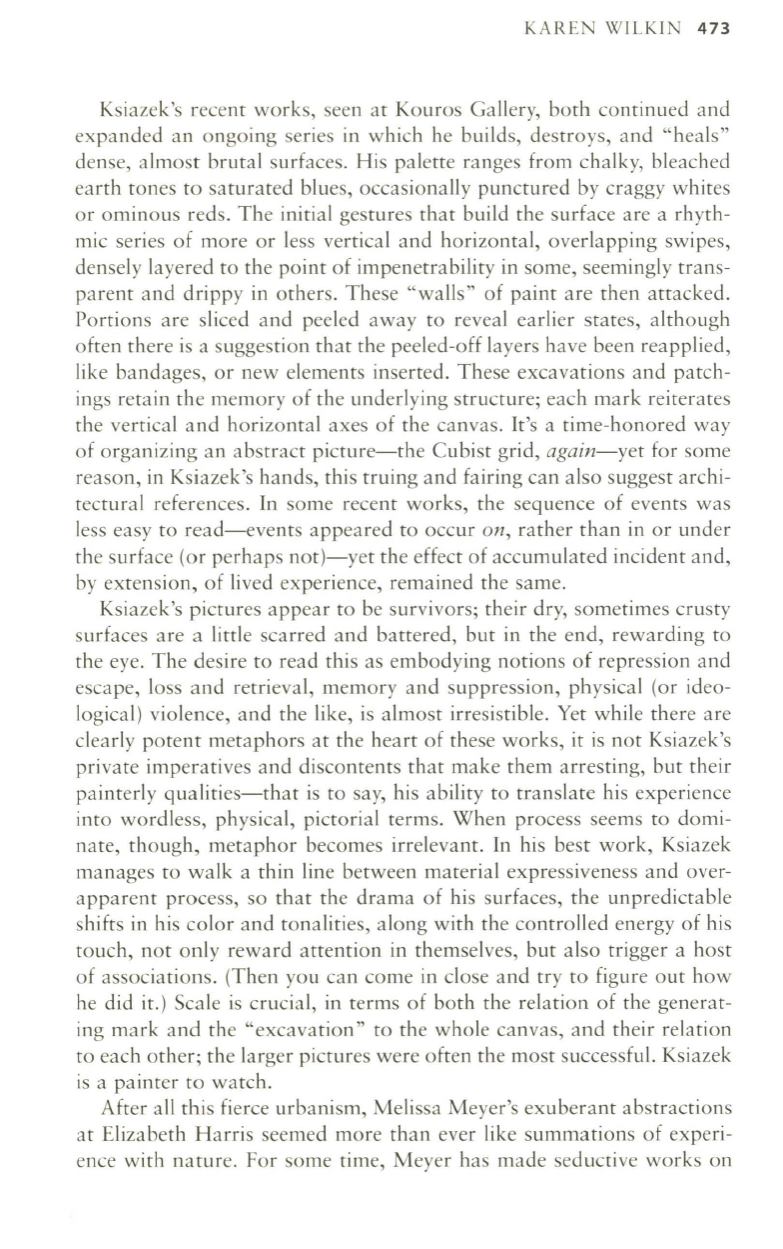
KAREN WILKIN
473
Ksiazek's recent works, seen at Kouros Gallery, both continued and
expanded an ongoing series in which he builds, destroys, and "heals"
dense, almost brutal surfaces. His palette ranges from chalky, bleached
earth tones
to
saturated blues, occasionally punctured by craggy whites
or ominous reds. The initial gestures that build the surface are a rhyth–
mic series of more or less vertical and horizontal, overlapping swipes,
densely layered to the point of impenetrability in some, seemingly trans–
parent and drippy in others. These "walls" of paint are then attacked.
Portions are sliced and peeled away to reveal earlier states, although
often there is a suggestion that the peeled-off layers have been reapplied,
like bandages, or new elements inserted. These excavations and patch–
ings retain the memory of the underlying structure; each mark reiterates
the vertical and horizontal axes of the canvas. It's a time-honored way
of organizing an abstract picture-the Cubist grid,
again-yet
for some
reason, in Ksiazek's hands, this truing and fairing can also suggest archi–
tectural references. In some recent works, the sequence of events was
less easy to read-events appeared to occur
on,
rather than in or under
the surface (or perhaps not)-yet the effect of accumulated incident and,
by extension, of lived experience, remained the same.
Ksiazek's pictures appear to be survivors; their dry, sometimes crusty
surfaces are a little scarred and battered, but in the end, rewarding to
the eye . The desire
to
read this as embodying notions of repression and
escape, loss and retrieval, memory and suppression, physical (or ideo–
logical) violence, and the like, is almost irresistible. Yet while there are
clearly potent metaphors at the heart of these works, it is not Ksiazek's
private imperatives and discontents that make them arresting, but their
painterly qualities-that is to say, his ability to translate his experience
into wordless, physical, pictorial terms. When process seems to domi–
nate, though, metaphor becomes irrelevant. In his best work, Ksiazek
manages to walk a thin line between material expressiveness and over–
apparent process, so that the drama of his surfaces, the unpredictable
shifts in his color and tonalities, along with the controlled energy of his
touch, not only reward attention in themselves, but also trigger a host
of associations . (Then you can come in close and try to figure out how
he did it.) Scale is crucial, in terms of both the relation of the generat–
ing mark and the "excavation"
to
the whole canvas, and their relation
to each other; the larger pictures were often the most successful. Ksiazek
is a painter
to
watch.
After all this fierce urbanism, Melissa Meyer's exuberant abstractions
at Elizabeth Harris seemed more than ever like summations of experi–
ence with nature. For some time, Meyer has made seductive works on


